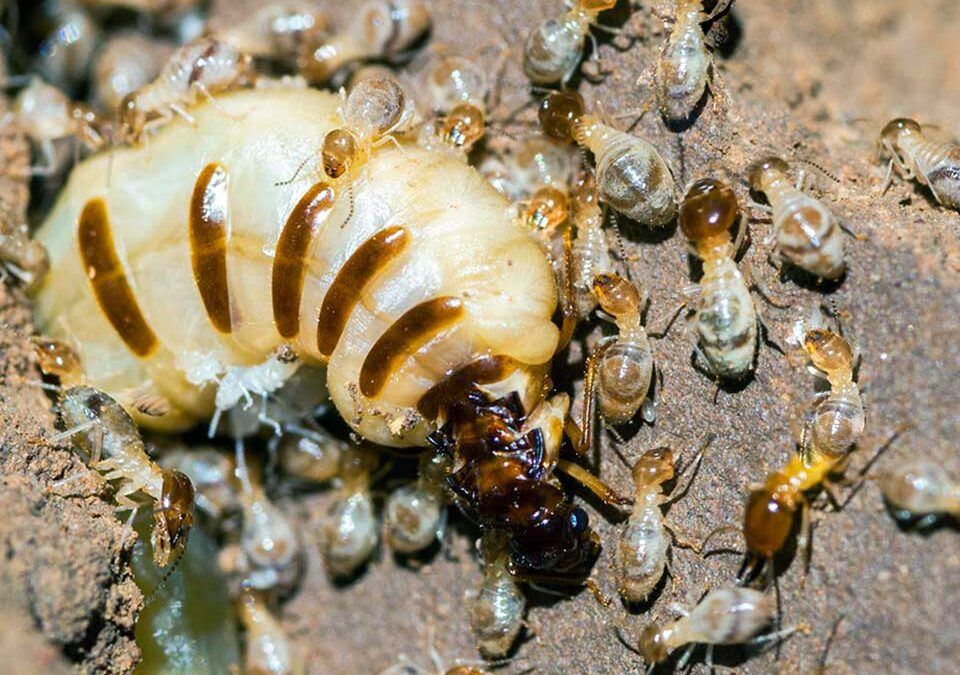Termites are a group of detritophagous eusocial insects which consume a wide variety of decaying plant material, generally in the form of wood, leaf litter, and soil humus. They are distinguished by their moniliform antennae and the soft-bodied and often unpigmented worker caste for which they have been commonly termed "white ants"; however, they are not ants, to which they are only distantly related. About 2,972 extant species are currently described, 2,105 of which are members of the family Termitidae.
Termites comprise the infraorder Isoptera, or alternatively the epifamily Termitoidae, within the order Blattodea (along with cockroaches). Termites were once classified in a separate order from cockroaches, but recent phylogenetic studies indicate that they evolved from cockroaches, as they are deeply nested within the group, and the sister group to wood eating cockroaches of the genus Cryptocercus. Previous estimates suggested the divergence took place during the Jurassic or Triassic. More recent estimates suggest that they have an origin during the Late Jurassic, with the first fossil records in the Early Cretaceous.
Similarly to ants and some bees and wasps from the separate order Hymenoptera, most termites have an analogous "worker" and "soldier" caste system consisting of mostly sterile individuals which are physically and behaviorally distinct. Unlike ants, most colonies begin from sexually mature individuals known as the "king" and "queen" that together form a lifelong monogamous pair. Also unlike ants, which undergo a complete metamorphosis, termites undergo an incomplete metamorphosis that proceeds through egg, nymph, and adult stages. Termite colonies are commonly described as superorganisms due to the collective behaviors of the individuals which form a self-governing entity: the colony itself. Their colonies range in size from a few hundred individuals to enormous societies with several million individuals. Most species are rarely seen, having a cryptic life-history where they remain hidden within the galleries and tunnels of their nests for most of their lives.
Termites' success as a group has led to them colonizing almost every global landmass, with the highest diversity occurring in the tropics where they are estimated to constitute 10% of the animal biomass, particularly in Africa which has the richest diversity with more than 1000 described species. They are important decomposers of decaying plant matter in the subtropical and tropical regions of the world, and their recycling of wood and plant matter is of considerable ecological importance. Many species are ecosystem engineers capable of altering soil characteristics such as hydrology, decomposition, nutrient cycling, vegetative growth, and consequently surrounding biodiversity through the large mounds constructed by certain species.
Termites have several impacts on humans. They are a delicacy in the diet of some human cultures such as the Makiritare in the Alto Orinoco province of Venezuela, where they are commonly used as a spice. They are also used in traditional medicinal treatments of various diseases and ailments, such as influenza, asthma, bronchitis, etc. Termites are most famous for being structural pests; however, the vast majority of termite species are innocuous, with the regional numbers of economically significant species being: North America, 9; Australia, 16; Indian subcontinent, 26; tropical Africa, 24; Central America and the West Indies, 17. Of known pest species, 28 of the most invasive and structurally damaging belong to the genus Coptotermes. The distribution of most known pest species is expected to increase over time as a consequence of climate change. Increased urbanization and connectivity is also predicted to expand the range of some pest termites.
-
Ancient Network Of Massive Termite Mounds In Brazil Are "Biological Wonders"
-
34,000-year-old termite mounds in South Africa are still being used
Megathreads and spaces to hang out:
- 📀 Come listen to music and Watch movies with your fellow Hexbears nerd, in Cy.tube
- 🔥 Read and talk about a current topics in the News Megathread
- ⚔ Come talk in the New Weekly PoC thread
- ✨ Talk with fellow Trans comrades in the New Weekly Trans thread
- 👊 Share your gains and goals with your comrades in the New Weekly Improvement thread
reminders:
- 💚 You nerds can join specific comms to see posts about all sorts of topics
- 💙 Hexbear’s algorithm prioritizes comments over upbears
- 💜 Sorting by new you nerd
- 🌈 If you ever want to make your own megathread, you can reserve a spot here nerd
- 🐶 Join the unofficial Hexbear-adjacent Mastodon instance toots.matapacos.dog
Links To Resources (Aid and Theory):
Aid:
Theory:

Bart is absolutely a genius. All three of the simpson kids are. Lisa is obviously Lisa, but bart on multiple occasions has been proven to not only be competent at his craft but the absolute best. Lisa had the advantage of being passionate about being percieved as smart. Bart has time and time again shown the accelerate quickly in his preffered fields. He surpassed her in musical ability in an increadibly short time. He surpassed her in chemistry when he could use it for destruction. He has the ability to be the best, he just rather do his own thing.
Maggie orchestrated an entire heist to retrieve her pacifier at less than a year old. That's an impossible task at an impossible age. She very well may be the greatest of the three
is bart autistic and only able to channel his intelligence towards his special interests?? you might think bart has social acuity, but where are all his friends? there's only Milhouse, not beating the autism allegations
If I remember it right, he canonically has adhd for sure
Pretty sure he's how people in the 90s perceived kids with ADHD.